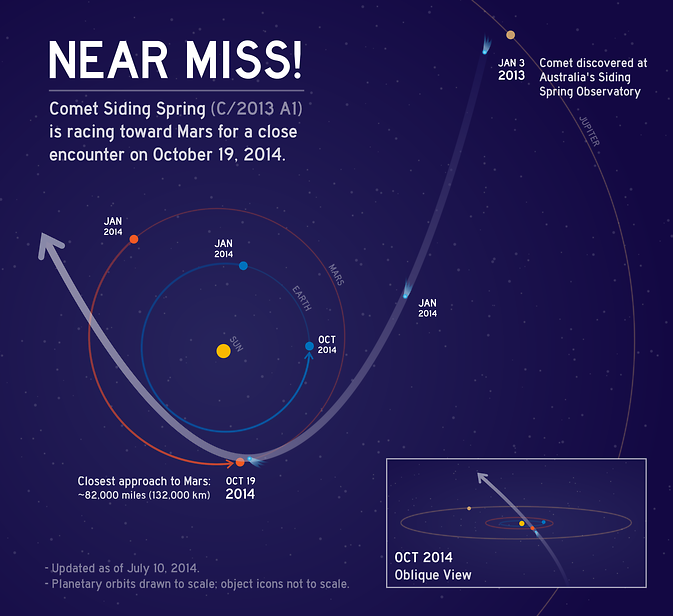NASA Prepares Mars Orbiters As Comet Siding Spring Heads Toward Red Plant For A Close Flyby

NASA is preparing its Mars orbiters to stay protected and gather valuable scientific data when a comet named C/2013 A1 Siding Spring closely flies by the red planet Oct. 19.
On the day of its close encounter with Mars, Siding Spring will pass by the planet at a distance of about 82,000 miles, dropping residue at nearly 35 miles per second, NASA reported. At such a velocity, even the smallest particle of half a millimeter in size could cause serious damage to a spacecraft, the U.S. space agency said. It currently operates two Mars orbiters, with a third one is expected to arrive in Martian orbit one month before the comet flyby. Scientists said they would have to position all spacecraft on the opposite side of Mars before the comet comes closer.
“Three expert teams have modeled this comet for NASA and provided forecasts for its flyby of Mars,” Rich Zurek, chief scientist for the agency’s Mars Exploration Program, said in a statement. “The hazard is not an impact of the comet nucleus, but the trail of debris coming from it. ... Mars will be right at the edge of the debris cloud, so it might encounter some of the particles -- or it might not.”

According to NASA, its Mars Reconnaissance Orbiter, or MRO, performed one orbit-adjustment maneuver July 2, while an additional maneuver is planned for Aug. 27. Meanwhile, the Odyssey Mars orbiter is planned for a similar maneuver Aug. 5.
NASA’s Mars Atmosphere and Volatile Evolution, or Maven, spacecraft, which is on its way to the planet, is scheduled to enter orbit Sept. 21. The team of scientists working on the Maven project is planning to conduct a precautionary maneuver Oct. 9.
At its closest, Siding Spring’s nucleus will pass by Mars at a distance that is 10 times nearer to that planet’s surface than any identified comet has ever flown past Earth, scientists said. They added the Mars orbiters will be at greatest risk nearly 90 minutes after the planet comes closest to the center of the widening dust trail from the comet’s nucleus.
The Maven orbiter will study gases emitted by the comet’s nucleus, while also looking for effects the comet flyby may have on Mars’ upper atmosphere. Odyssey will study thermal and spectral properties of the comet’s coma -- a cloud around the nucleus -- and tail, and MRO will monitor Mars’ atmosphere for possible temperature increases and cloud formation, NASA said.
© Copyright IBTimes 2024. All rights reserved.





















